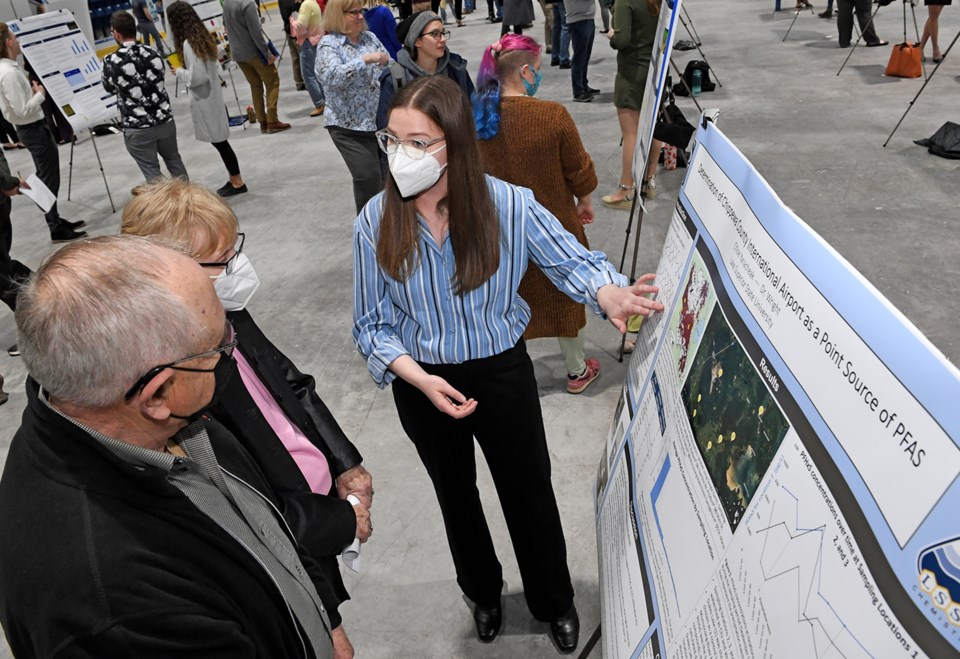Studies by environmental chemistry students at Lake Superior State University have opened a window into how widespread uranium and a “forever” chemical compound is in the Eastern Upper Peninsula.
First, the forever compound.
The PFAS – an acronym for polyfluoroalkyl substances – family of compounds are a “secret sauce” of sorts used in manufacturing since the 1940s. One hundred have been cataloged since discovery in 1936. Sixteen PFAS compounds have proved useful in everything from cosmetics to camping gear. It gives slipperiness to Teflon, conveys resistance to heat and water, and has been a godsend for firefighting. Six types of PFAS make foam spread out to squelch flames faster after car and aircraft accidents, especially ones that have explosive fuels. Thousands of lives have been saved over the years.
The downside is that PFAS compounds never break down. They flow through water into lakes and wells. And, like the pesticide scare of DDT in the 1960s, scientists have found they accumulate in the tissues of humans and can cause health problems.
Against this background LSSU student Chloe Yanacheak set out to track PFAS compounds being carried by creeks and runoff water from Chippewa County International Airport into Lake Munuscong, 16 km to the east.
PFAS-impregnated foam was used for 20 years when the airport was Kincheloe Air Force Base, and for almost three more decades after the base became a regional airport. PFAS in firefighting has tapered off since the early 2000s as other substances developed as replacements.
Yanacheak sampled surface water at seven locations progressively downstream from the airport. For the first time, her study tracked a PFAS compound unique to firefighting foam.
“The good news is that PFAS levels are virtually nonexistent in Lake Munuscong,” she said. “Duke Lake, my closest sample to the airport, has the highest concentration but still well under actionable levels suggested by the state.”
Yanacheak’s study confirmed how the natural flow of water from the airport is conveying the chemical to Lake Munuscong, but at levels surprisingly low.
“The state is closely monitoring wells and water sources around the airport,” she added. “Airports and former military bases continue to be hotspots around the country.”
Another LSSU student, Stephanie Owens, designed her study to look for PFAS in areas around the Eastern Upper Peninsula. Aside from sampling near active and former airfields, she expanded sites to include campgrounds in Trout Lake, Sheldrake Dam – near Whitefish Point – and on Big Manistique Lake west of Newberry.
“PFAS concentrations at campgrounds surprised me,” she said. “In sampling through the summer, I had spikes in August. Dr. Derek Wright (Owens’ project advisor) thinks we might be seeing runoff from waterproofing in tents.”
Campground concentrations were even higher than in Kinross Lake, just northwest of Chippewa County Airport. Owens chalks this up to the lake being upstream from the airport. As Yanacheak found, water flows south into Lake Munuscong.
“We see measurable concentrations near where activities use PFAS products – airport firefighting and recreational camping,” she said.
In both studies, measured concentrations fell well under levels that require action, which can range - depending on the type of PFAS compound - from 8 to 96 micrograms per liter of water.
Another forever substance, this one natural, uranium, was found in surprising amounts from samples drawn from more than three dozen wells on Sugar Island.
“Uranium infuses up from below because we sit on top of porous sandstone layers,” said Olivia Ludlow, who analyzed 84 samples. “I expected to see higher amounts of uranium from deeper wells, but not the levels I saw in some shallower wells.”
She and advisor Derek Wright speculate that shallower wells packed closer together can draw uranium up from below at a greater rate, much like people sharing several straws in a milkshake.
“Twenty-eight of 84 samples had levels of uranium above the recommended federal limit,” said Ludlow. “Only two high-uranium wells were deeper than 107 metres. High uranium numbers showed up in seven wells shallower than 30 metres. This could be from how they are clustered.”
Wright and Ludlow shared their data with homeowners, county health, and the state.
“Homeowners should test more often as more wells get drilled nearby,” advised Ludlow. “They should also invest in capable filter systems.”
